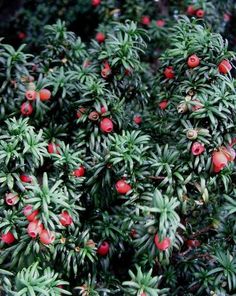Yew (Taxus baccata) Plant Description:
Taxus baccata, commonly known as yew, is an evergreen coniferous tree that holds cultural and historical significance. Here’s a detailed description of the plant:
Plant Type:
Yew is an evergreen tree.
Foliage:
Needles: Dark green, needle-like leaves that are arranged spirally on the stem.
Texture: The foliage is dense and has a fine texture.
Toxicity: All parts of the yew tree, except the fleshy aril around the seed, contain toxic alkaloids. Caution should be exercised when handling the plant.
Cones:
Yews produce small, inconspicuous seed cones that are surrounded by a fleshy, berry-like structure called an aril.
The aril is typically red, although it can be yellow, orange, or even translucent.
Size:
Yews can vary in size, from small shrubs to large trees.
They can be pruned into various shapes and are often used for hedging.
Growth Habit:
The growth habit is typically upright and conical, but it can vary depending on the specific variety.
Bark:
The bark is reddish-brown to grayish and becomes scaly as the tree matures.
Flowers:
Yews have separate male and female plants. Male plants produce small, inconspicuous pollen cones, while female plants produce seed cones.
Berries:
The fleshy arils surrounding the seeds are often referred to as berries.
These berries are not true berries botanically but are commonly referred to as such.
Hardiness:
Yews are hardy and adaptable, growing well in various climates.
They are well-suited to temperate regions.
Sun Requirements:
Yews can tolerate a range of light conditions, from full sun to partial shade.
They often thrive in dappled shade.
Soil Conditions:
Well-draining soil is essential for yew trees.
They are adaptable to different soil types but prefer slightly acidic to neutral soils.
Moisture Needs:
Yews prefer evenly moist soil.
Once established, they are relatively drought-tolerant.
Uses:
Yews are commonly used as ornamental trees and shrubs in gardens and landscapes.
They are popular choices for formal hedges and topiary due to their dense foliage and ability to tolerate pruning.
Cultural Significance:
Yew trees have historical and cultural significance and are often found in churchyards and older landscapes.
Some ancient yew trees are among the oldest living trees in Europe.
Pruning:
Yews respond well to pruning and can be shaped into various forms.
They are often used for topiary and formal hedging.
Yew trees, with their dark green foliage, distinctive red berries, and adaptable nature, are versatile and widely used in landscaping. Their longevity and the ability to regenerate from old wood contribute to their popularity in various garden settings.












Reviews
There are no reviews yet.